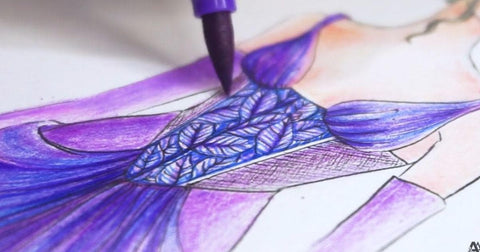The Art of Ombré: Tips for Creating Beautiful Gradations of Color in Your Artwork
Last Updated: October 13, 2025

Ombré art has been around for centuries, and it's not hard to see why.
The beautiful color transitions and gradations of color make for stunning artwork that can be appreciated by anyone. Whether you're a seasoned or beginner artist, creating artwork with an ombré effect can be a fun and rewarding experience.
In this blog post, we will delve into the captivating realm of ombré art and provide you with valuable tips and techniques to create stunning gradations of color in your artwork.
But first, let’s learn a little about the origin and uses of ombré.

What Is the Origin of Ombré?
Ombré is believed to have originated in France in the 19th century as a term used to describe a gradual blending or shading of colors in textile treatment.
Where did ombré come from?
The term "ombré" originates from the French word “ombrer” meaning "shaded" or "shadow." It refers to a gradual transition of color from light to dark or vice versa.
The ombré technique has been used in various art forms for centuries, including textiles, painting, and hair styling. In recent years, ombré has gained popularity in fashion, interior design, and even nail art. Its versatility and visually appealing effect make it a timeless and widely appreciated artistic technique.

What are some common applications of ombré in design and art?
-
Fashion: Ombré is frequently used in clothing, especially in dresses, skirts, and tops. It adds a gradient effect to the fabric, creating a visually appealing and dynamic look.
-
Hair: Ombré hair has become a popular trend in recent years. It involves dyeing the hair in a gradient effect, with the roots being darker and gradually lightening towards the ends.
-
Nail Art: Ombré nail art is another common application. It involves blending colors on the nails to create a gradient effect. This technique can be done using various colors and can be customized to suit individual preferences.
-
Home Decor: Ombré is often used in home decor items such as curtains, bedding, and cushions. It adds a touch of color and visual interest to the space.
-
Painting: Ombré can be used in painting to create depth and dimension. Artists often use this technique in abstract or landscape paintings to create a smooth transition between colors.
- Graphic Design: Ombré is frequently used in graphic design, particularly in backgrounds, logos, and illustrations. It adds a modern and stylish touch to the design.
Tips on Creating Gradations of Color in Your Artwork

1. Choose Your Colors Wisely
The first step in creating ombré art is choosing your colors. You want to choose colors that blend well together and create a smooth transition from one color to the next. Start with two colors that are next to each other on the color wheel, such as blue and green, or red and orange.
Read more on The Magic of Color Theory: Understanding Color Relationships and Harmonies in Your Artwork.
When choosing your colors, consider the emotions and atmosphere you want to convey as well. Warm colors like red, orange, and yellow can evoke energy and passion, while cool colors like blue, green, and purple can create a sense of calmness and tranquility.
As you become more comfortable with ombré painting, you can experiment with more colors and different color combinations.

2. Pick Your Tools and Mediums
Experiment with different tools and mediums to achieve unique ombré effects. Brushes with soft bristles or blending tools can help create smooth transitions. Explore various art mediums such as acrylics, watercolors, pastels, gouache, etc. to add your personal touch to the ombré technique.

3. Mix Your Colors
Once you've chosen your colors, it's time to mix them. You want to create a smooth gradient from one color to the next, so it's important to mix your colors well. Use a palette knife or watercolor brush to blend the colors together until you achieve the desired effect.
|
4. Start with a Base Coat
Before you start painting your ombré effect, it's important to start with a base coat. This will help ensure that your colors blend smoothly together and create a seamless transition. Use a light coat of paint that matches your lightest color as your base coat.

5. Start Painting
Now it's time to start painting your ombré effect! Start with the lightest color at the top of your canvas and gradually work your way down to the darkest color at the bottom. Use long brush strokes and blend your colors together as you go.

Remember, by mastering this technique, you can evoke different moods, create striking visual effects, and enhance the overall aesthetic appeal of your artwork.
Learn some quick painting techniques in the video below:
6. Blend Your Colors
As you paint, it's important to blend your colors together to create a seamless transition. Use a dry brush or a blending tool to blend your colors together and create a smooth gradient.

Here are a few blending techniques to help you achieve beautiful gradations:
- Wet-on-Wet Technique: Apply wet paint onto a wet surface to allow colors to blend naturally and create soft transitions.
- Dry Brush Technique: Use a dry brush with minimal paint to create textured and gradual color changes.
- Layering Technique: Build up layers of translucent colors gradually, allowing each layer to dry before adding the next, creating subtle gradations.

7. Practice Makes Perfect
Creating beautiful gradations of color takes practice, so don't be discouraged if your first attempt doesn't turn out exactly how you envisioned it.
Start with small projects to familiarize yourself with the technique. Don't be afraid to experiment and embrace imperfections as they can add character and uniqueness to your ombre art.
Here are more tips on How to Create Better Depth and Perspective in Paintings.

Start Creating Gradations of Color in Your Next Art Project!
Ombré art is a beautiful and rewarding form of artwork that can be enjoyed by anyone.
By understanding the fundamentals, choosing the right colors, mastering blending techniques, exploring different tools and mediums, and embracing experimentation, you are well on your way to creating beautiful gradations of color in your artwork. So go forth, unleash your creativity, and let the art of ombré transform your creations into captivating masterpieces!
Remember, ombré art is an ever-evolving technique, so keep exploring, learning, and refining your skills. With dedication and practice, you'll soon become a master of the art of ombré!
Come visit The Creative Corner for more art tips, tricks, and inspiration.






